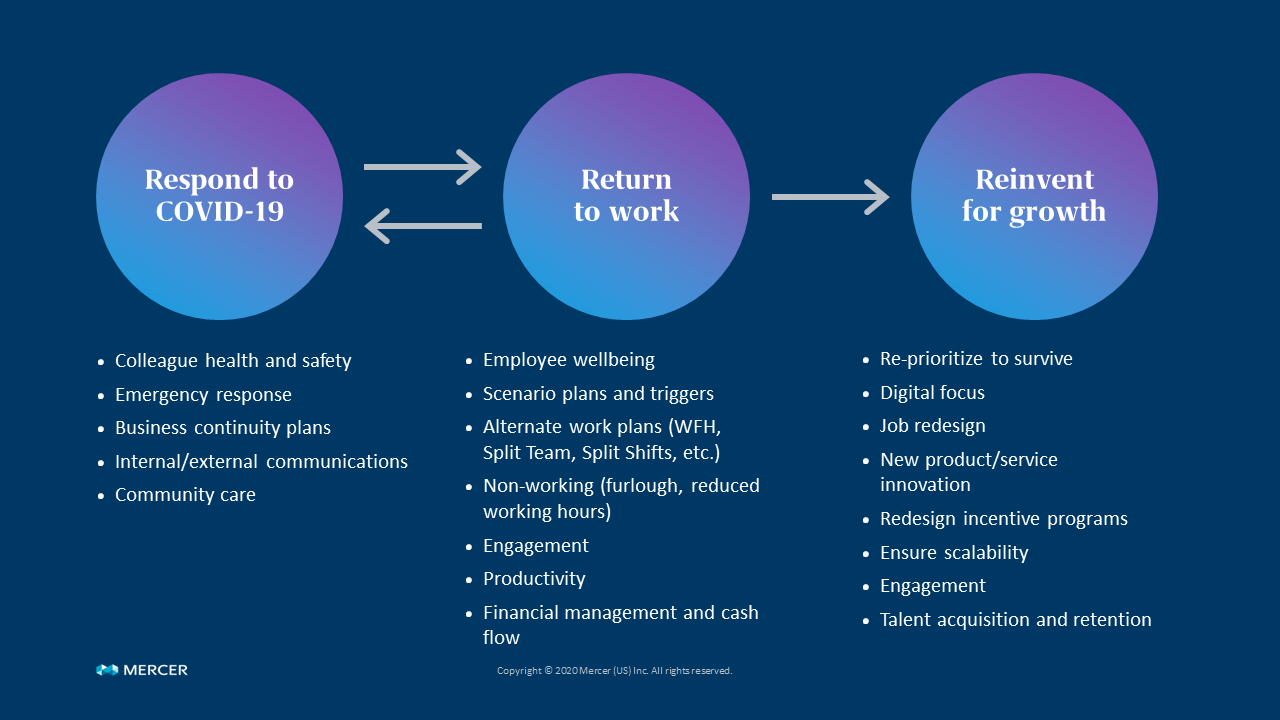Insights from Asia: Managing Return to Work
 © 2019 Yiu Yu Hoi
© 2019 Yiu Yu Hoi
Conversations about when businesses shut by COVID-19 can reopen are ramping up. Americans are asking when they can return to work – and business leaders are asking what they must do to get ready. To provide some perspective on this question, we invited CEOs of Mercer operations in Asia to speak on a webcast, "Insights from Asia", to share their experiences and learnings from the pandemic. While we urge you to listen to the replay, this article summarizes the key points.
Just as the pandemic itself is unfolding in stages, the return to economic activity will happen in stages. Much of the US is still in the early stage of widespread community transmission. Once social distancing and other measures to slow the spread have had sufficient impact, local municipalities will feel comfortable enough to relax restrictions and take steps to restart our economy. But since there isn’t a COVID-19 vaccine, we should anticipate a post-peak phase, where new cases will arrive and new or limited restrictions may need to be implemented.
Managing the impact of COVID-19 in three phrases
Reacting to COVID-19.The first phase is the emergency response, focused on colleague health and safety and implementing business continuity plans. The reality is that for most organizations, this phase is a scramble to secure needed supplies, continue operations, and put out an enormous amount of internal and external communications, often on the fly.

Returning to work. Once you’ve gotten a handle on the crisis phase, it’s time to begin thinking about your business. In the return-to-work phase, planning is critical. You need to build out scenario plans based on social distancing measures continuing for one, two, three or even four months. Evaluate the business impact, the cash flow requirements and the cost-saving tactics you’ll need under each scenario. As you establish how and when your employees should return to the workplace, work through how to recall furloughed and reduced-hour employees and what alternative working arrangements (e.g. work from home, split shifts, split team) to deploy to minimize potential exposure. Consider options for on-site assessments of employee health.
In addition to logistical plans, think about what you can do to ensure your employees are productive, physically well and mentally strong. Most importantly, they need to know that they are returning to safe work sites. Some may be grieving a COVID-19-related loss and need additional support. It is essential to address lingering anxiety, as this drains engagement and productivity.
While we hope this phase will lead directly to the growth phase, a linear path isn’t guaranteed. Plan for a post-peak phase that may result in a return to reacting to COVID-19. Should that occur, it’s helpful to have a playbook that incorporate lessons learned and includes draft communications you can use should the need arise. Hear what Peta Latimer, CEO, Mercer Singapore had to say about the post peak phase her country is currently experiencing (her remarks start at the 29:33 mark).
Reinvent for growth. Employers in Asia are just starting this phase. The return to work is slower than expected and the “V”-shaped recovery business leaders had hoped for isn’t happening because they are trying to rebound in the context of a global recession instead of a robust global economy. It’s important for US businesses leaders to start thinking about how they will reinvent for growth in a weak economy. Will you place more emphasis on digital products, or will you rely on innovations to pull you through? It’s possible that you’ll need to establish new business priorities to survive. Hear what Catherine Li, CEO, Mercer China has to say about China’s rebound in a soft economy (her remarks start at the 18:50 mark).
Be prepared for consumer demand to be soft. Many companies coming back from shelter in place orders will quickly learn that return to work does not equal return to normal. Many businesses will be cash constrained and everyone will be aggressively fighting for market share. On the brighter side, compared to prior recessions, today companies have more tools to tackle these challenges. There are some significant opportunities available to us if we remain thoughtful and proactively agile. Remember it is far easier to make changes when the world around you is already shifting -- when people are operating in gray, rather than staunchly holding to their black and white views.
Listen to our webcast replay to learn from our Asia leaders about managing through a pandemic.
